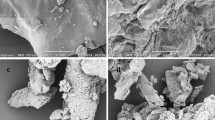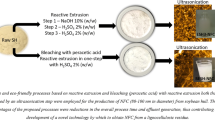Abstract
Soybean hull is an agroindustrial waste which has not been fully studied as a food ingredient. The aims of this work were to obtain insoluble fibers from soybean hull and to evaluate the effect of high pressure homogenization (HPH) on its physicochemical properties. Hull insoluble polysaccharides (HIPS) were obtained in a single step, as the insoluble residue after pectin removal. FTIR showed bands corresponding to cellulose and hemicellulose in HIPS, and thermogravimetric analysis showed two degradation events at 236.3 °C and 325.6 °C, corresponding to cellulose and hemicellulose, respectively. HIPS dispersions (pH 3.00) were subjected to HPH by three cycles at increasing pressures (up to 1000 bar), obtaining soybean hull nanofibers. SEM images show that HPH at 1000 bar reduced the dimensions of the fiber bundle from 30 to 90 μm in length and 9–15 μm in diameter to nanofibers of 10–30 μm in length and 100–400 nm in diameter. AFM further confirms a heterogeneous distribution of sizes in HIPS800 and HIPS1000, evidencing the presence of individual nanofibers with diameters around 50 ± 10 nm and 40 ± 10 nm, respectively, with several μm in length. Furthermore, an increase in water holding capacity from 2.1 to 61 gwater/gdry matter and viscosity from 0.39 to 34,945 Pa.s were achieved as HPH at 1000 bar treatment was applied. HPH increased the interfacial area and promoted the interconnection of fibers in a hydrated gel-like structure. This explains flow behavior, which was extensively studied in this work: three-region viscosity profile (shear-thinning, plateau or shear-thickening and shear-thinning) and a pronounced hysteresis loop. Oscillatory rheology was used to study the viscoelastic behavior of HIPS dispersions. HIPS are a source of nanofibers, easy to obtain through a single step of chemical treatment followed by the application of high pressures. It is remarkable that the use of few chemical solvents is favorable from an environmental point of view. This work also suggests a potential application of HIPS to improve physicochemical and structural properties in acidic foods.

Graphical Abstract








Similar content being viewed by others
Abbreviations
- HIPS:
-
soybean hull insoluble polysaccharides
- HF:
-
soybean hull flour
- HPH:
-
high pressure homogenization
- PSD:
-
particle size distribution
References
USDA, 2018. https://apps.fas.usda.gov/psdonline/circulars/production.pdf
R. Gnanasambandam, A. Proctor, Food Chem. 65, 461–467 (1999)
M. Elleuch, D. Bedigian, O. Roiseux, S. Besbes, C. Blecker, H. Attia Food Chem. 124, 411–421 (2011)
Q. Li, A. Al Loman, A.M. Coffman, L.K. Ju, J. Biotechnol. 248, 35–42 (2017)
H.M. Liu, F.Y. Wang, Y.L. Liu, Food Chem. 202, 104–109 (2016)
Y. F. M. Kishk, H. M. A. Al-Sayed, LWT Food Sci. Technol., 40, 270–277 (2007)
R. M. Raybaudi-Massilia, J. Mosqueda-Melgar, in: The Complex World of Polysaccharides, ed By In Tech (Croatia 2012), p 429–454
A. Alemdar, M. Sain, Bioresour. Technol. 99(6), 1664–1671 (2008)
J. Chen, D. Gao, L. Yang, Food Res. Int. 54, 1821–1827 (2013)
L. Cheng-mei, L. Rui-hong, D. Tao-tao, Y. Jiang-ping, Z. Zi-cong, L. Shun-jing, C. Jun, Food Hydrocoll. 57, 55–61 (2016)
O. Ketenoglu, B. Mert, A. Tekin, J. Texture Stud., 45(4), 295–306 (2014)
G.O. Aspinall, J.N.C. Whyte, J. Chem. Soc. (972), 1964–5058 (1964)
G.O. Aspinall, K. Hunt, M.I. Morrison, J. Chem. Society (C), 1966–1945 (1966)
G.O. Aspinall, K. Hunt, I.M. Morrison, J. Chem. Soc. (C), 1967–1080 (1967)
A. Ferrer, C. Salas, O.J. Rojas, Ind. Crop. Prod. 84, 337–343 (2016)
W.J. Mullin, W. Xu, Food Res. Int. 33, 883–891 (2000)
W.J. Mullin, W. Xu, J. Agric. Food Chem. 49, 5331–5335 (2001)
M.C. Porfiri, J.R. Wagner, Food Hydrocoll. 79, 40–47 (2018)
D.M. Cabezas, M. Pereira Ortiz, J.R. Wagner, M.C. Porfiri, Food Res. Int. 97, 62–70 (2017)
U. Kalapathy, A. Proctor, Food Chem. 73, 393–396 (2001)
M.C. Porfiri, D.M. Cabezas, J.R. Wagner, J. Food Sci. Technol. Association of Food Scientists & Technologists 53(2), 956–967 (2016)
I. Morrison, Phytochemistry 27, 1097–1100 (1988)
TAPPI Standard methods. TAPPI Standard T 203 om-09. www.tappi.org
TAPPI Standard methods. TAPPI Standard T 222 om-11. www.tappi.org
B.L. Browning, Methods of Wood Chemistry, vol II. Cap. 19 B- Método 3b (Wiley, New York, 1967)
C. Nkonge, G.M. Ballance, J. Agric. Food Chem. 30(3), 416–420 (1982)
M. Abramoff, P. Magalhaes, S. Ram, Biophoton. Int. 11, 36–42 (2004)
C.J. Chirayil, L. Mathew, S. Thomas, Rev. Adv. Mater. Sci. 37, 20–28 (2014)
F.Y. Wang, H.Y. Li, H.M. Liu, Y.L. Liu, Bioresoueces 10(3), 5256–5266 (2015)
R. Sepe, F. Bollino, L. Boccarusso, F. Caputo, Compos. Part B 133, 210–217 (2018)
H. Yang, R. Yan, H. Chen, D.H. Lee, C. Zheng, Sci. Direct Fuel 86, 1781–1788 (2007)
M. Poletto, A.J. Zattera, R.M.C. Santana, J. Appl. Polym. Sci. 126, E336–E343 (2012)
D. Dai, M. Fan, Vib. Spectrosc. 55, 300–306 (2011)
I.H. Parvez, S. Feride, J. Mol. Catal. B Enzym. 7, 207–221 (1999)
P.L.M. Barreto, A.T.N. Pires, V. Soldi, Polym. Degrad. Stab. 79, 147–152 (2003)
L. Burhenne, J. Messmer, T. Aicher, M.P. Laborie, J. Anal. Appl. Pyrolysis 101, 177–184 (2013)
H.S. Kim, S. Kim, H.J. Kim, H.S. Yang, Thermochim. Acta 451(1–2), 181–188 (2006)
A. Clarke, T. Prescott, A. Khan, A.G. Olabi, Appl. Energy 87, 3680–3690 (2010)
D.J. Mc Clements, Food Emulsions: Principles, Practice and Techniques (CRC Press, Boca Raton, 1999)
J. Ahmed, S. Al-Jassar, L. Thomas, Food Hydrocoll. 48, 72–83 (2015)
R. Lapasin, S. Pricl, Rheology of Industrial Polysaccharides: Theory and Applications (Blackie Academic & Professional, Glasgow, 1995)
M. Iotti, O.W. Gregersen, S. Moe, M. Lenes, J. Polym. Environ. 19, 137–145 (2011)
U. Florjancic, A. Zupancic, M. Zumer, Chem. Biochem. Eng. Q. 16(3), 105–118 (2002)
H.Y. Yu, L. Wang, K.L. McCarthy, J. Food Drug Anal. 24, 804–812 (2016)
J.A. Teggatz, H.A. Morris, Food Struct. 9, 133–138 (1990)
X. Jia, Y. Chen, C. Shi, Y. Ye, M. Abid, S. Jabbar, P. Wang, X. Zeng, T. Wua, Food Hydrocoll. 39, 27–33 (2014)
M.P. Lowys, J. Desbrières, M. Rinaudo, Food Hydrocoll. 15, 25–32 (2001)
A. Karppinen, T. Saarinen, J. Salmela, A. Laukkanen, M. Nuopponen, J. Seppala, Cellulose 19, 1807–1819 (2012)
E. Saarikoski, T. Saarinen, J. Salmela, J. Seppala, Cellulose 19, 647–659 (2012)
Acknowledgements
Authors wish to thank Terminal 6 S. A. (Santa Fe, Argentina) for kindly providing us with soybean hulls. AFM was carried out in INIFTA-CONICET, UNLP, Argentina.
Funding
This study was funded by Universidad Nacional de Quilmes (R&D Grant PUNQ 53/1037); and Agencia Nacional de Promoción Científica y Tecnológica (PICT-2015-0084; PICT 2017–1540).
Author information
Authors and Affiliations
Corresponding author
Ethics declarations
Conflict of Interest
The authors declare that they have no conflict of interest.
Additional information
Publisher’s Note
Springer Nature remains neutral with regard to jurisdictional claims in published maps and institutional affiliations.
Rights and permissions
About this article
Cite this article
Colletti, A.C., Delgado, J.F., Cabezas, D.M. et al. Soybean Hull Insoluble Polysaccharides: Improvements of Its Physicochemical Properties Through High Pressure Homogenization. Food Biophysics 15, 173–187 (2020). https://doi.org/10.1007/s11483-019-09613-y
Received:
Accepted:
Published:
Issue Date:
DOI: https://doi.org/10.1007/s11483-019-09613-y




